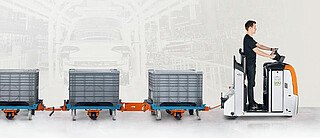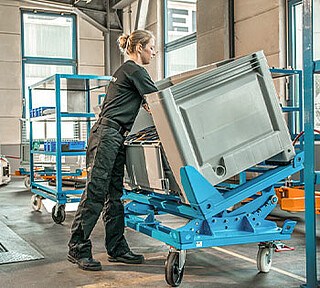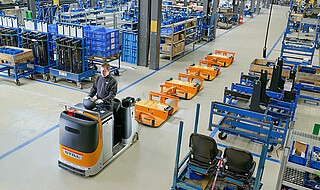What is "Just-in-Time" (JIT)?
A simple guide to lean logistics

Every business is looking to make improvements in their processes. For companies that manufacture goods or store and supply inventory, a lean and efficient supply chain is essential to maximising profitability and passing savings onto customers. ‘Just-in-Time’ (JIT) is a key methodology of lean logistics, and one we specialise in at STILL, helping bring efficiency improvements to our customers. But what is ‘Just-in-Time’? And how can material handling equipment help implement “lean logistics” systems? We’ll explain here.
What is Just-in-Time?
‘Just-in-Time’ or JIT is a system of managing inventory, warehouse stock, or even human resource within manufacturing or supply chains. It was developed in Japan in the 1960’s in vehicle manufacturing. By delivering vehicle parts just before they were needed in the manufacturing process, valuable storage space was saved and thus productivity improved. Today supply chains around the world benefit from “lean logistics” processes like JIT, here’s how.
How does JIT improve quality in a supply chain?
For a supply chain, implementing a ‘Just-in-Time’ system for the purposes of stock inventory can help minimise excess stock, and reduce waste across your warehouse. As a result, inventory can be moved more quickly through the supply chain, be stored for less time and cost less to reach the end user. Successfully adopting a ‘Just-In-Time’ system to your supply chain will need an in-depth understanding of your customers’ demands for inventory. Unusual spikes in demand or delays in previous steps in the supply chain can create challenges.
What are the advantages of “lean logistics”?

Commercially applying “lean logistics” methods like ‘Just-in-Time’ will streamline your supply chain and lower the costs passed onto the customer. Adopting “lean logistics” in the warehouse or factory can lead to having less equipment involved in processing inventory across the supply chain. Switching from heavy forklift trucks to lighter and more agile order pickers and tugger trains will save on your operating costs and ultimately cost less in terms of up-front investment. A ‘Just-in-Time’ system will also reduce the processing time for each forklift truck, resulting in a faster more efficient material flow across your supply chain.
7 benefits of Tugger Trains when using a ‘Just-in-Time’ (JIT) system
Tugger Trains have been synonymous with “lean logistics” and production since the methodology was first introduced in the 1960’s. Japanese manufacturers identified that by using a forklift truck which could tow components around the factory (and stop at the right step in production at the right time) meant that their whole manufacturing process was made more efficient.
Tugger Trains bring several benefits to supply chains that have adopted a ‘Just-in-Time’ (JIT), ‘Just-in-sequence’ (JIS) or timed logistics systems. Here’s where you can make those efficiency improvements:
1. Less warehouse traffic
Instead of multiple forklift trucks individually driving around to source inventory, a tugger train will consistently travel the same route and stop at the same points, loading and unloading what is needed. As a result, you’ll find less traffic, noise, operating costs and manpower needed to meet the same supply demand.
2. Improved warehouse safety
Having a coordinated tugger train operating across a warehouse is far safer than several forklift trucks crossing separate paths. Your inventory and most importantly your staff are less at risk of being involved in an accident.
3. Increase supply and process reliability
The true value that tugger trains offer becomes clearer once you have implemented a ‘Just-in-Time’ system into your material flow process. By aligning production or supply timings with the sequence of a tugger train you can ensure your processes are reliably supplied around the clock and thus preventing supply shortages or delays in manufacturing.
4. Increase production in the same production space
Tugger trains were perfected in environments where space was limited, supplying parts to assembly areas quickly and regularly using a ‘Just-In-Time’ system. If your warehouse or production space is small, then switching to a tugger train could increase your productivity.
5. Production becomes more individual and product variety increases
Customisation and variety are prevalent in supply chains more than ever thanks to customer demands for individuality. Where a production or supply chain demands more parts or variety then a digitally controlled tugger train can meet this supply, delivering smaller volumes of inventory right when it’s needed in the supply chain or production process.
6. Financial advantages
The reduction in costs by using tugger trains have already been shared in this article, but where can a company see these cost saving benefits? Compared to a conventional forklift truck, tugger trains require less manual handling by staff and improve the transparency of your supply process; all thanks to the cyclical way they operate. Through optimal planning, tugger trains can help facilitate next day delivery services for goods and save on operational costs, all through the predictable method by which they handle materials.
7. Ergonomic work
The health and safety of your staff is essential to maintaining an efficient supply chain, with fewer injuries contributing to faster productivity. With a standing driving position and ergonomic assisting features like height adjustable trolleys; STILL’s tugger trains make both operating and access to loads easier.

STILL, masters of “lean logistics”
At STILL, we work alongside our customers to introduce “lean logistics” solutions like tugger train systems. As you’ll be well aware in logistics, one size does not fit all, that’s why our experts work with you to tailor a materials handling solution perfectly suited to your business. Contact us to find out more.
Comments
No comments
Subscribe to the blog !
Be informed as soon as an article is published. You can unsubscribe anytime.

Leave a comment